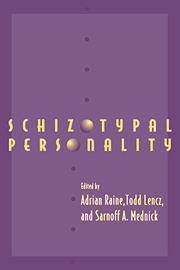Book contents
- Frontmatter
- Contents
- List of contributors
- Preface
- Acknowledgments
- Part I Introduction
- Part II Genetics and neurodevelopment
- Part III Assessment
- Part IV Categorical versus dimensional approaches
- Part V Psychophysiology and psychopharmacology
- Part VI Neuropsychology
- Part VII Brain imaging
- 16 Brain morphology in schizotypal personality as assessed by magnetic resonance imaging
- 17 The potential of physiological neuroimaging for the study of schizotypy: experiences from applications to schizophrenia
- Part VIII Conclusion
- Part IX Appendix
- Name Index
- Subject Index
17 - The potential of physiological neuroimaging for the study of schizotypy: experiences from applications to schizophrenia
from Part VII - Brain imaging
Published online by Cambridge University Press: 04 August 2010
- Frontmatter
- Contents
- List of contributors
- Preface
- Acknowledgments
- Part I Introduction
- Part II Genetics and neurodevelopment
- Part III Assessment
- Part IV Categorical versus dimensional approaches
- Part V Psychophysiology and psychopharmacology
- Part VI Neuropsychology
- Part VII Brain imaging
- 16 Brain morphology in schizotypal personality as assessed by magnetic resonance imaging
- 17 The potential of physiological neuroimaging for the study of schizotypy: experiences from applications to schizophrenia
- Part VIII Conclusion
- Part IX Appendix
- Name Index
- Subject Index
Summary
With the increased recognition that schizotypy is a legitimate nosological entity that deserves systematic investigation from phenomenological, psychological, and neurobehavioral perspectives, it has become evident that neuroimaging methods should be considered for gaining insight into its pathophysiological substrates. Some pioneering studies using anatomical neuroimaging methods are described in the previous chapter. It is probably fair to suggest at this point that although significant differences in neuroanatomical measures between individuals with schizotypy and healthy controls have been reported, the effects are subtle and the overlap in values is considerable. This should not be surprising, since the same summary would be valid for the (literally) hundreds of such studies in schizophrenia. Thus, the odds are that neuroanatomical abnormalities will explain only some of the behavioral variance associated with schizotypy. While such efforts to establish structural aberrations are prerequisite for interpreting further findings on neural substrates of a behavioral disorder, the hope for larger and more pervasive effects can be turned toward methods for physiological neuroimaging. Behavioral deficits associated with brain disorders can be more extensive than what is attributable to the death of neurons in regions showing anatomical damage. They can be caused by brain cells that are not dead, but are either insufficiently active or too active. Some grave forms of brain dysfunction are caused by abnormalities in regional brain physiological activity.
Keywords
- Type
- Chapter
- Information
- Schizotypal Personality , pp. 406 - 426Publisher: Cambridge University PressPrint publication year: 1995
- 1
- Cited by



